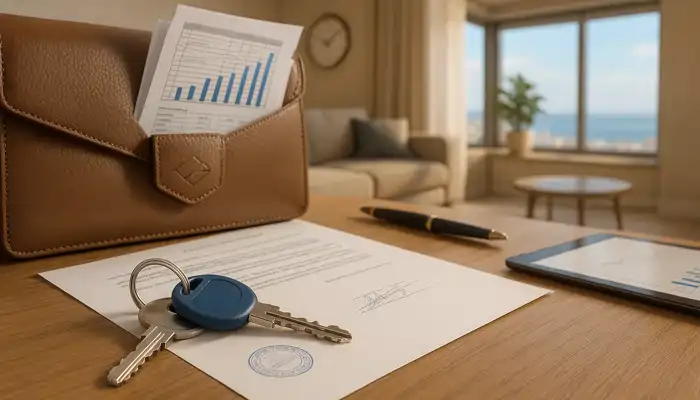Mortgages in Spain: Relevance and Main Issues
Sunny Spain attracts foreigners with its mild climate, beautiful architecture, and favorable conditions for buying property with a mortgage. However, potential borrowers often have questions and concerns:
- Complexity and length of paperwork
- Need to translate a large package of documents into Spanish
- Language barrier when dealing with banks and notaries
- High or "non-transparent" interest rates
- Lack of understanding of the tax payment scheme and associated costs
To successfully complete all stages and avoid overpaying, it is important to study the requirements of Spanish banks in advance and prepare properly for the transaction. Below, we will look at the conditions a foreigner may face, what documents need to be collected, and how to apply for a mortgage (a loan to purchase real estate) in Spain.
How a Foreigner Can Get a Mortgage in Spain: A Step-by-Step Guide
Below are the main steps for obtaining a mortgage loan for non-residents, as well as key points to pay attention to. To begin with, it is important to understand that, in most cases, foreigners are subject to a higher down payment requirement and a more scrupulous solvency check. However, the process remains feasible if you know the nuances.
Step 1. Analyzing Bank Offers and Choosing a Program
The first and most important step is to study the offers of different banks, comparing not only interest rates but also additional requirements. Usually, the following parameters are considered:
- Loan term (up to 20-30 years, but for non-residents, restrictions are sometimes stricter)
- Interest rate: fixed, floating, or combined (in Spain, the Euribor index is the benchmark for floating rates)
- Loan amount (usually up to 70-80% of the appraised value of the property for foreign buyers)
- Fees for mortgage origination, account maintenance, life and property insurance
To compare options, you can contact a mortgage broker who is familiar with the Spanish loan market, or analyze several banking products yourself.
Step 2. Opening an Account and Obtaining an NIE (Foreigner Identification Number)
In order for a Spanish bank to consider your application, you will need to open an account there and transfer the amount to cover the down payment, as well as transaction costs. Next, you need to obtain a NIE (Número de Identificación de Extranjero) certificate, which serves as a foreigner's identification number and tax number in Spain.
Without an NIE, the bank cannot issue a mortgage, and you will not be able to register the property in the official registries. This document is issued at the Spanish police station or at the Spanish consulate outside the country.
Step 3. Concluding a Preliminary Agreement (FIPER)
After choosing a bank and confirming that you want to apply for a mortgage there, the borrower signs a FIPER (Ficha de Información Personalizada). This is a document that sets out the main terms of the loan and the validity period of the offer. During the specified period, the bank does not change the main parameters (interest rate, amount, term, etc.), and the borrower has time to collect the remaining documents.
Step 4. Property Valuation by an Independent Company
Spanish banks issue loans based on an expert appraisal of the property. For this, an independent licensed organization is involved. It determines the real value of the property, taking into account its condition, age, location, and other characteristics. Usually, the bank is willing to finance 70-80% of the appraised (not the contractual) value.
Step 5. Preparing Financial Documents
The main task is to show the bank your solvency. It is necessary to collect and translate into Spanish (through an official sworn translator) the following documents:
- Income certificates (2-NDFL (Personal Income Tax Certificate) for the past year and current months, and for individual entrepreneurs (IE) - 3-NDFL (IE Tax Return) and 2-NDFL for the current months)
- Statements from all bank accounts for at least 6 months (movement of funds and balance)
- Certificate from work confirming position, salary, and length of service
- Documents on property ownership (if any: extracts from registers, lease agreements, proof of profitability)
- Certificate of clean credit history (for example, from the National Bureau of Credit Histories (NBCH) in Russia or a similar bureau in another country)
The more reliably you confirm your income, the more favorable the bank's conditions will be.
Step 6. Additional Services and Insurance
Many banks in Spain require the connection of related products, such as life insurance in favor of the bank, home insurance, and the issuance of a bank card. Keep in mind that such services affect the final amount of the monthly payment. Sometimes the bank is willing to lower the interest rate if the borrower agrees to a full package of insurance and financial products.
Step 7. Signing the Oferta Vinculante
When the documents are collected, the bank prepares the Oferta Vinculante - this is a binding mortgage offer. It details all the terms of the loan. The borrower has several days (usually at least 10) to study the document and ask questions.
Step 8. Notarization of the Transaction
The most important stage is the signing of the official notarial deed of sale and the mortgage agreement. In Spain, all real estate transactions are made only through a notary. The notary certifies the correctness of the documents, verifies the identity of the parties, and records the fact of the conclusion of the contract.
Step 9. Payment of Taxes and Registration in the Property Registry
After notarization, it is necessary to pay the property transfer tax, fees, duties, and fees (notary, registrar, etc.). Then the transaction is registered in the Registro de Propiedad (Property Registry). Only after registration do you become the full owner with the right to further dispose of the property.
Step 10. Home and Life Insurance
The final stage is the signing of life and property insurance contracts in favor of the bank, if this is stipulated in the mortgage conditions. Insurance is a guarantee of protection of the interests of the lender (and partly the borrower) in case of unforeseen situations.
Main Requirements of Spanish Banks for Foreigners
Most banks in Spain are loyal to non-residents, but they set certain requirements:
- Age of the applicant - usually from 21 to 70 years old
- Down payment of at least 20-30% of the appraised value of the property
- Proof of stable income, as well as the availability of sufficient funds to cover transaction costs (taxes, notary, registrar)
- Payment-to-income ratio: the monthly mortgage payment is 2-3 times less than the officially confirmed income
- Clean credit history in the country of residence (at least the absence of serious debts and delinquencies)
If you meet these criteria, there is a high chance of a positive decision. Additionally, it should be taken into account that the bank pays attention to your citizenship and country of tax residency, as well as the stability of the exchange rate of the currency in which you receive income.
Important Expenses and Associated Fees
Before proceeding with the mortgage application, it is necessary to take into account the associated expenses. They can significantly affect the final amount:
- Mortgage origination fee - 1-1.5% of the loan amount (depends on the bank and the specific program)
- Property appraisal - about 300-500 euros
- Home insurance and (in some cases) life insurance
- Property transfer tax - approximately 10% of the value for most regions
- Registration fees, notary services, etc.
It is reasonable to have a small reserve in case of unforeseen expenses. And if you want to reduce the interest rate, check with the bank for the conditions for comprehensive service (salary account, insurance, etc.).
Tips for a Successful Mortgage Application in Spain
- Try to save a sufficient down payment. The more you can pay upfront (for example, not 20%, but 30-40%), the higher the chance of getting a favorable rate.
- Prepare all documents in advance, especially financial certificates, statements, and translations into Spanish.
- Compare conditions at different banks. Do not limit yourself to one offer, so you can find the best one.
- Realistically assess your income. You should take into account future expenses for housing maintenance, possible repairs, utilities, etc.
- Consult with specialists. The help of a mortgage broker and an English-speaking lawyer in Spain can save you from the difficulties associated with ignorance of local laws.
Conclusions: Why a Mortgage in Spain is a Real Tool for Foreigners
Spanish banks have been issuing loans to foreign citizens and non-residents for many years, without requiring guarantors or collateral in another country. The main requirement is financial reliability. At the same time, many buyers choose resort and urban properties for subsequent rental, which often allows them to "self-finance" mortgage payments.
Compliance with basic conditions, having an NIE, properly prepared documents, and a clear understanding of the application process can turn the procedure of obtaining a mortgage in Spain into a manageable and predictable process. If you have a stable income and a desire to buy property on the coast or in major cities, a Spanish mortgage will be an excellent solution to realize your dream.








